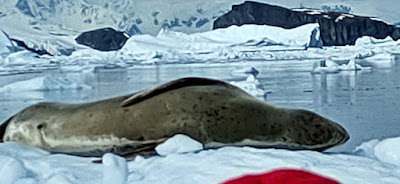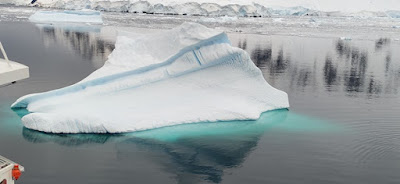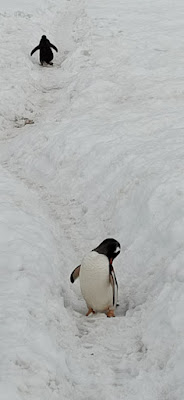We were so thrilled with our first cruise to Antarctica that we got another last-minute deal and went again! Same 5-star, all-inclusive luxury line, but this time in a suite. The Swan Hellenic
Vega was our ship this time, a bit smaller, but awesome in all respects. Above is Jason doing his 2nd Polar Plunge.
This wine was a premium (pay extra for it) wine available for dinner. Note the name Lynch and Bages.
A third of the passengers on this cruise were from a charter group from Cornell University in Ithaca, NY. They provided lectures from some of their professors while we were on the cruise, too. Here, Jason is feeling the baleen material from a whale's mouth, a prop to pass around from one of the ship's crew who lectured about the whales we might see. Baleen is made of keratin, like our nails and hair.
Caves in icebergs--so cool. That is a huge chunk of ice floating out here.
Nils, one of the guides from Norway was one of our favorites.
We had a fairly smooth Drake Passage crossing so got to do a bonus night landing on Robert Point where we saw more Gentoo and Chinstrap penguins.
Molting elephant seals were laying around as well. They are grumpy while molting and don't go back into the water til their old fur is gone, so they are hungry, but lazy.
This is also one of the few places you can still see a glacier coming right down to the ocean water.
These seals just lay all over each other, occasionally picking a fight or heaving themselves onto one another. They make a lot of grunting and farting noises, too.
These seals don't eat the penguins, so they coexist.
Penguins on the rocky high spots on the point.
Karen at the top of a walk through the penguin rookery.
Line up to sleep, boys.
A lone seal snuggles into his rocky spot.
Whales came by to feed just off the bow. The blow of one and the tail flukes of another here. Even though we had a long motor to reach our next destination, the Captain stopped the boat for an hour or more so we could watch this pair feed. They'd dive and then lunge up and onto their sides with a gulpfull of krill.
A wonderful iceberg with its own cave in it.
The sunset in the wake of
Vega, This shot was at 9:30 or 10 PM at least.
Jason on a Zodiac ride to a landing, with the ship in the background.
Penguins on the shore.
The outdoor grill/BBQ/bar was open a couple of times on this cruise. Excellent food.
Fanciful shapes on icebergs.
Looking down over the side of the railing, we got really close to some of these bergs.
The prow of the boat moving through pancake ice.
A glacier as seen from the ship as we move through a channel.
Karen on an upper deck as we plow through the little bergy bits to a new destination. We had some really good weather again.
A leopard seal asleep on a floating berg.
Leopard seals have a lizard-like shape to their heads, evident in this one. They are the apex predator here and eat penguins.
We mostly saw seals just sleeping.
Frilly ice.
Just a pretty view.
Lapping waves have left a dimpled texture on this iceberg.
Our guide grabbed a big chunk of floating ice for us to look at. If you put it in your drinks, it pops as the bubbles in the ice release air from centuries ago. But the ships aren't allowed to collect ice for drinks anymore.
You can see striations in the ice from times when it was compressed more and the air bubbles were squeezed out of it to make the ice more clear.
Chunks of ice scrape along the hull of the ship as I look over the railing. Scratches in the paint make it evident this happens a lot.
This looks like chunks fell on a berg already in the water.
Another lazy seal on a floating iceberg.
I love these arches in the ice!
This berg had 3 arches in it! We took the Zodiacs to see this one later.
Jason as we took a Zodiac cruise through the ice fields.
The intricate details amazed me. These grooves are from melting water dribdling down the ice face.
The tip of this one could calve off any time. We watched a chunk fall from one of the arches in that three-arch berg and the guide exclaimed "That's why we can't drive the Zodiacs through the arches! You just never know when the ice could give way. "
Jason and the arch.
Lots of blue ice here. Blue usually means the ice has been compressed. It could also be from the iceberg rolling over.
Shapes that tickle our imagination.
Another side of that triple arch berg. It's pretty amazing that it hasn't collapsed under its own weight so far.
Jason and Karen in the Zodiac. By now it was snowing again.
You can see a few pieces still falling to join that chunk that is now floating. It used to be part of the ceiling!
Wow again and again here in Antarctica!
The blue stripe on this berg is from a period of ice compression.
The 'foot' of the iceberg, the part underwater is the dangerous part for ships.
Delicate and intricate were two adjectives I wouldn't have thought I'd use for Antarctica.
Jason and Karen on one of our landings.
A young Weddell seal was snoozing and giggling in its sleep near the walk path.
He woke up to change position, check out all the folks taking photos of him and then laid back down to re.some mo
On his back, swishing back and forth to get comfy.
Jason following a walking path set out by our guides. They made sure we weren't bothering the wildlife and the snow was walkable.
Jason snagged a piece of ice during a Zodiac ride. Snaggletooth.
Karen and Jason on the way to/from the ship. The parkas they gave us were wonderful.
A huge knob of ice sticking up out of the sea. Our dirty minds thought it looked like a giant penis.
The bird flu has closed Port Lockroy to visitors, and it claims to have the southernmost post office in the world. Bad weather on the day we stopped as well. So the caretakers from the Antarctic British Heritage Trust brought the post box and most of their souvenir shop out to the boat for us to shop and buy and mail postcards or letters. The stuff was priced in British Pounds and was very pricey. They did a hopping business, though.
The post box from Port Lockroy.
This is what I though all of Antarctica would look like, very stark and inhospitable.
Karen on an upper deck as we approach the Lemair Channel, aka the Kodiak Gap, where we wil snake through the icebergs to reach a bay beyond. The rocky cliffs close in as we approach.
Morebeautiful bergs.
A glacier comes down to meet the channel,
Looking forward through the gap.
More cool caves in the ice along the edges.
Icebergs in the channel as we navigate through.
How are we supposed to get around all these safely?
The little chunks of ice indicate a recent calving or a big chunk breaking up. Or a ship plowing through an iceberg and breaking chunks off!
Jason dressed warmly for our passage.
How did this ever get shaped like this?
We sideswiped one of the bigger ones and broke a big part of it off as we passed. Thank goodness the ship was built to handle this stuff. We could take on ice up to 3 1/2 feet thick if we had to.
We made it through.
Jason on the top deck outside by the ship's flag.
The poor little penguin had to jump onto the slippery green rocks because we were coming in for a landing.
These guys are so cute to watch waddle around. Gentoo penguins.
Penguins have taken over the rock cairn that stranded workers had built to attract attention when they were caught on the ice. They died but the penguins are happy here and feeding chicks and protecting eggs.
They look up and make noises to brag or warn others.
There is a chick under te penguin on the right. A little grey blob.
Nests made of stones.
The Swan Hellenic
Vega waiting for us offshore. A fabulous home away from home for a couple of weeks.
Exposed rocks a bit further on from the rock cairn on Peterman Island.
Penguin in a pool by the sea.
Their wings are always back for balance as they walk.
More chicks under the parents.
These 'penguin highways' get pretty deep. They follow the same path repeatedly to/from the ocean.
Mama and baby penguins.
The Adelie penguins seemed to like sliding on their bellies to get around.
Penguin rookery.
The pink is from penguin poop, full of krill remains.
An icy overhang above a cave in an ice cliff.
Pink penguin prints in the snow.
Hurrying to some location.
This penguin didn't make it.
More bergs.
This one looks like it has a swimming lane built into the middle of the iceberg.
Antarctic ice is special, eh?
He looks up as we motor by but doesn't move off.
Hurrying back to the rookery.
Jason and Karen on the snow.
Karen and Jason next to a penguin highway. The crossed poles mark as far as we are supposed to go. We always step over the highways, not into them.
Another delicate art piece of ice.
Jason and Paul, a new friend from the UK. They are like minded and we spent most meals with him and his son Denis. Great company!
Getting a little close here, Captain....
We took a bit off this one as we had to navigate a very tight path through a narrow channel. You can see how still it was, though.
I saw this iceberg calve itself into many pieces. It just peeled like a flower blooming in fast motion.
More rivulets creating little gullies in the ice
Love those arches.
A few penguins on the tip of this one.
What does your imagination think this one looks like?
Beautiful blue bergs.
This one looked like a glass mushroom to me.
Looks like a frozen waterfall.
Whale bones and water boats on Peterman Island.
Gentoo penguins in one of their highways.
People nearby made some of them a bit nervous and they jumped the highway and raced off in a new path.
Huge piles of huge whale bones. Used to be a whaling station here.
Karen and Jason in front of whale bones and water boats.
Lots of different shapes and sizes to these bones.
Coming through Neptune's Bellows at Deception Island, the walls of the caldera are a bright red against the black and white of volcanic ash and snow. It was the only color around.
You might think this was taken in black and white, but this is the black volcanic sand and ash above and below the white ice and snow around this caldera of a quiet but alive volcano.
Jason's polar plunge photo was the favorite of the Expedition Leader, Brandon, on the left. It mdke the nightly recap and briefing slides.
And this is Denis doing his best immitation of a salmon for his polar plunge. It too made the evening briefing.
Jason feeling how hot the sand and water is on shore. Too hot to leave your fingers in for more than a second! Sulphurous steam rose along the shore in places as well on Deception Island.
A skua sitting in the warm sand. They eat penguin eggs and chicks and are one of the most affected by the bird flu. That may be why it let us get close enough for a photo.
These little brittle stars got cooked in the hot shallow waters and washed ashore.
A little sea urchin on the beach sand surprised me, too.
A big whalebone half in the water on the black sand shore.
This fur seal at the end of the beach ws enjoying the warm sands to snooze until we all traipsed up to take pictures. He moved a bit farther down the beach.
Looking over the edge of the Neptune's Window. A black sand beach and a bunch of seabirds. Folks with vertigo shouldn't look over this edge.
Jason on the edge of the cliff at Neptune's Window,
Chunky rocks from the edge of the caldera have fallen and littler the sand. Lichen is starting to cover them.
This strange thing is salp, a sea animal that pulses to move through the water. It attaches to others to form strings. The orange dots are the stomachs. It changes from male to female and back again to breed and is a secondary food for whales when krill isn't plentiful. A strange new thing for us to see.
Our Zodiacs lined up on the warm sands of Deception Island with
Vega in the background. This was the only time we beached the dinghies all at once. Usually they were ferrying different groups off and on the landing sites to keep the numbers down.
Karen on the beach at Deception Island.
Steam from the geothermal waters under the surface of the sand.
Abandoned whale oil tanks on Deception
More abandoned equipment after the1969 eruption killed 37 men and the British left the station.
Housing is falling apart

The sign for the Biscoe House is still legible.
The inner rooms are full of snow and ice.
The airplane hangar was built when little planes used to fly researchers and crew in and out of here.
Skua in the sand.
Karen and Paul as we stopped at the champagne barge the ship had sent out to meet us on our way back from our last outing.
Black ash on white snow.
White snow on black ash on white snow.
The towering rock at the entrance to the caldera port in Deception Island, known as Neptune's Bellows because the wind is funneled through the narrow opening.
A flock of penguins swimming outside of Deception Island. A huge rookery covers the hilltop of one side of the entrance.
The bridge tour, the heart of navigating the ship, was so popular they had to extend it to a second day and kick people out when we were to go through a tight pass. With all the modern equipment available, they still use prayers as a good backup.
The hand decorated chart of our voyage that was auctioned off on the last night. It went for $2250, with proceeds benefiting the crew welfare fund. There's some artistic talent in this crew!
The places we visited on our cruise were highlighted on the chart. A wonderful piece of art and a great memento.
Jason and Nils in a conversation. He was outspoken and informative about the history of Norwegians and Antarctica.



























































































































































































































